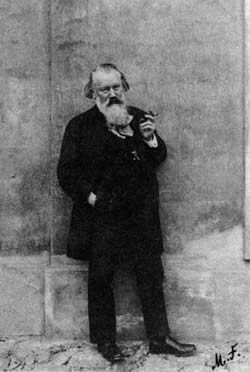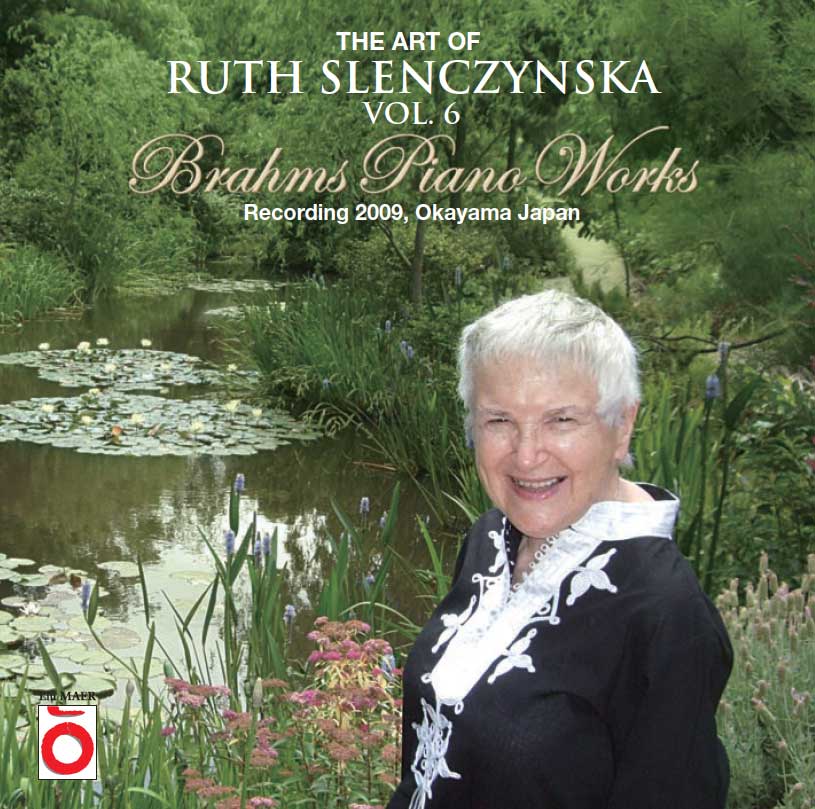Piano Works by Brahms – Ripe Maturity of His Lifetime
By Bunsho Mifune
Let us now consider Brahms’ music carefully. Why are there a fine lot of devoted lovers and players of Brahms’ music?
Johannes Brahms (1833– 97), you will be astonished by the brilliance how every element of his life had been woven in the very best way when a retrospective review in detail is concerned. His family environment, encounters, love (It was never reciprocated.), his relationships with others, the historical background, his own temperamental traits, personality and his blessed talent – all of them improved an amazing harmony for his unique art. It is as if invisible power took command of his life in order to give humankind celestial bliss.

The works by Brahms have these characteristics as follows: the beautiful melodies and rhythm that include extreme passion and noble elegance, rich harmony, and high-quality finished form lined with perfectly accurate technique of composition (i.e. counterpoint and so on). The real art of music always has both supreme afflatus and polished craftsmanship. And yet it is deeply true that a lot of people have been enchanted by his music.
As a son of the father who played contrabass for making a living, Brahms grew up in a slum quarter of Hamburg until he reached 20 years old. The poor surroundings of his childhood bestowed not abstract but persevering foundation upon his music. Being introduced by Joachim, Brahms knocked the door of the Schumanns when he was 20 years old. On that day he was recognized by both the Schumann couple. Therefore, Brahms could immediately absorb outstanding artists’ influence into himself fully. Very soon he was by Robert’s bedside when he tragically passed away. It was Clara Schumann who became the cherished object of his yearning with a depth. And it was Brahms who devoted himself heart and soul to take care of Clara and seven children(!) for several years when her husband passed away. In this way Brahms had already experienced feelings of joy and grieving in his young days. At the same time this fact must have enabled him to understand the subtleties of emotion.
However, the fate did not befriend him to achieve recognition in the world. Overcoming trials on each stage of his life, he developed himself. He had a strong desire to learn and was curious. On religion, philosophy, aesthetics, history, politics, literature and etc. – Brahms’ reading covered a wide range. He collected famous composers’ original manuscripts since baroque period, transcribed, revised and published them. It means that he made a profound study of former composers. The potentialities of one of the great and orthodox successors to the Western music art can be discerned.
What is more, he was fortunate enough throughout all his life to have been in an environment where famous players, artists, scholars and fans of the various genres treated him like family. Beginning with Clara Schumann and Joachim, they made his life rich and colorful and provided him a sense of stability, for Brahms remained single. (Especially he told Clara Schumann most of his first plans, and her advice, opinions, response and helpful criticism were welcomed. Therefore, wellspring of his creative works was shared with his friends, polished and carefully selected in due course of time.
There is one more element that makes his works attractive.
Owing a debt of gratitude to those who were close to him, Brahms wearied to death by having a rough tongue without remembering where he is. He loved nature and children. He frankly brought about a feeling of repulsion against vulgarity that pollutes purity. On the other hand, he wished working in the fields of high status. Yet he was not attached to money, so he devotedly helped community, his juniors and friends. He was difficult to strangers, bur he behaved quite natural among his old and trusted friends. Brahms was loved as a man of compassionate understanding, good humor and great intellect.
Not only heavenly bestowed afflatus and experienced craftsmanship but also his genuine heartedness and his dedicated way of living – all of these humane characteristics touch us unconsciously.
Generally speaking, a work of art displays the scenery of one’s lifetime. The same is true of Brahms’ piano music. (Compared with other composers, especially his piano pieces reflect the impact and changes of his life’s four seasons beautifully clear.)
Brahms once said to one of his friends, “Simply because my father was contrabassist, I played on the cello. However, my teacher ran away with my instrument.” If it were not a joke, that is why he started playing on the piano. From his teens upward he supplemented the family income by playing on the piano in a bar. When he visited the Schumanns at the age of twenty, both Robert and Clara were surprised at his playing the Piano Sonata Opus 1 (of his own composition). In those days Robert had been sick, yet he enthusiastically wrote in New Journal for Music: “This is the one whom God has sent to us!” Thanks to the article, soon Brahms became widely known as a composer. Nevertheless, he earned his living rather as a pianist, not as a composer.
The Hungarian Dances (piano piece for four hands) was a great success when Brahms arranged it at the age of 36. This enabled him to receive the royalties. As a result he took the initiative for a composer to depend his whole life only on royalty income. Most of his orchestral works and chamber music are arranged into piano works according to the requirement of publishers. Therefore, Brahms expresses himself the very best by means of piano. It would not be an overstatement to say that he spent his entire life in playing on the piano.
His great three Piano Sonatas were composed until he was 23 years old. Since then around 10 variations and arrangements were written for a period of ten years. And after ten more years when he was 45 years old (Opus 76 and 79, total 10 works), 20 years later at the age of 59 years old there are Opus 116, 117, 118, 119; the total up to 20 works – all of them are absolutely unique. Of course a great number of chamber music and songs were composed during those periods. Although the piano lies at the heart of his works, piano solos might have been not enough to cover his unbounded composition initiative, being full of creation drive.
Brahms’ piano pieces have been always polished and went through a transition. His technique of composition evolved through the accumulation of further elaboration. In the end the 30 works (Opus 76-119) show us the whole development of his carefulness. Bach, Haydon, Mozart, Beethoven, Schubert, Mendelssohn, Schumann and Chopin – they are his seniors. As the result in the absorption and digestion of those great composers, Brahms is successful in creating his own unique world, having inherited the essence of his seniors. Here Western piano music has reached the loftiest pinnacle, and this also includes a sign of the music in the 20th century (the first piece of Opus 119, for instance).
There are a lot of official great works that appeal Brahms as a famous composer. (I am grateful enough to God for the existence of those achievements). It is truly significant how deep, beautiful and rich is the invisible world of Brahms, when we listen to these piano pieces behind his fame.
It is without mentioning that the player gives life to the work. Fine performance consists in polished techniques and delicate imagination like a poet. These 30 works of Brahms require more, for each piece is like a precious jewel. In other words, they bring hommage to his senior masters’ work. First of all, it is necessary for the pianist to be well acquainted with composer’s works before Brahms. Second, Brahms’ melody expresses the very best essence of the Romanticism in the 19th century. Therefore, deep understanding of the Western culture is quite indispensable, too.
84-year old Ruth Slenczynska has challenged Brahms’ works as the consummation of her performing arts. What makes very precious to the recordings this time is the fact that she is the very person who has directly inherited the tradition of great masters in the 19th century such as Schnabel, Backhaus, Cortot, and Rakhmaninov. Then we know her as a great contributor to the evolution of pianism in the 20th century. She would readily suggest us what the true value of piano music art in the 21st century is.
translator Kiyoko Kruzliak

The Art of Ruth Slenczynska VI
- Recording
- June 12th – 14th, 2009 Liu Mifune Art Ensemble
- Piano
- Steinway made in 1926 in Liu Mifune Art Ensemble
- Performance
- Ruth Slenczynska (Piano)
ラスト・コンサートから4年、84歳の伝説の巨匠ルース・スレンチェンスカが自らのピアニズムの集大成として描き出した、優しくも美しい幽玄なる未知のブラームスの内面世界!
- An Invitation to the Rich but Unknown World of Brahms – 84 year-old Ruth Slenczynska
- Piano Works by Brahms – Ripe Maturity of His Lifetime
 〒703-8266 岡山県岡山市中区湊836-3
〒703-8266 岡山県岡山市中区湊836-3

